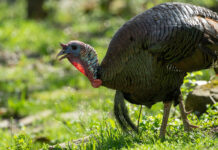The sign-up period is open for the new Dairy Margin Coverage Program (DMCP) at Farm Service Agency offices across the country.
The Dairy Margin Coverage Program is the newly renovated replacement for the former Dairy Margin Protection Program introduced in the 2014 Farm Bill.
The program was a revenue protection tool that offered an opportunity for farmers to purchase coverage of a margin between $4 and $8 per hundredweight of milk.
This margin, calculated monthly, represents the difference between the USDA all-milk price, and a calculated feed cost that is supposed to represent the feed cost for a cow and her replacement.
The 2018 Farm Bill renamed the program, and addresses some of the most frustrating issues of the DMPP.
These include how feeds were priced in the margin calculation, and insurable margins below the long-term national average (Figure 1).

Feed cost changes
When one set of costs is used to represent dairy farms across the country, they are representative of no one. Costs in Ohio are different Texas or California.
The farm bill required a review of feed cost calculations, a hay price based on a survey of prices in the top 5 dairy states and a review of corn silage costs of production.
As a result, the previously announced margins for January-March were recently recalculated with the revised formula and prices and were revised down a total of 78 cents.
In other words, calculated feed costs were higher with the new formula, and no doubt more realistic.
New margins
Two of the biggest changes that will positively impact farms of all sizes include:
1) adding three new margins, $8.50, $9 and $9.50, at reasonable premiums for the first five million pounds of production (Tier 1 milk); and
2) allowing farms with base production of more than 5 million pounds to make a second margin election for pounds over the first 5 million (Tier 2 milk) (Figure 2).

This second change allows farms with more than five million pounds of production history to fully participate in the $9.50 margin for their Tier 1 milk, then select a lower level of coverage for their Tier 2 milk.
With the much higher premiums for Tier 2 milk, some farms were unable to participate at the higher coverage levels on their first five million pounds of milk, because they had to purchase the same coverage for all of their milk.
The extremely high premiums for Tier 2 coverage above the $5.50 level were impractical and uneconomical.
With the new second selection option, if a farm buys up coverage to $8.50, $9 or $9.50 per cwt. on their first 5 million pounds, they may choose a level between $4 and $8 for their remaining Tier 2) pounds (Figure 2).
Production history is still based on the highest documented amount of milk sold in 2011, 2012 or 2013.
If a farm participated in the DMPP, it will have earned some annual production “bumps” based on national production performance.
If a farm was not in DMPP, production history will be based on the higher of 2011, 2012 or 2013 production.
Bottom line: Check with your Farm Service Agency office to confirm what your production history is for the DMC program.
Production history increases
Annual increases were a feature of the DMPP, but they are no longer part of the new DMC program. Your production history will be the same for the life of the Farm Bill, 2018 through 2023.
Past premium credits
An unexpected feature of the DMC program is the opportunity to recover program participation net losses from 2014 through 2017.
Repayment can be received as cash (50% of the loss), or by applying it to premiums for participation in this year’s program (75% of the loss).
For example, if a farm purchased $6.50 margin coverage in 2016, paid a premium of $3,500 and received a total indemnity payment of $500, they had a $3,000 net loss. The farm could choose to receive half the difference, or $1,500 as a cash payment. The other option is to receive $2,250, or 75% of the amount, as a credit toward premiums for future DMC participation.
If you participated in any or all of those years, you will receive notification from your Farm Services Agency office with any amounts and options.
Sign-up open
Just like last year, sign-ups for 2019 opened after Jan. 1, but participation will be retroactive to Jan. 1.
We know the announced margins for January ($7.71), February ($7.91), March ($8.66), April ($8.82) and May ($9).
Sign-ups end Sept. 20, and selections can be changed up to that date.
No need to wait
For farms covering up to 5 million pounds of base production, indemnity payments for January through May more than cover the premiums at the highest ($9.50) margin.
For example: production history: 5,000,000 pounds (about 200 cows). Farm elects to cover 95% of their base, 4,750,000 pounds, or 47,500 cwt.
Production is divided equally over 12 months regardless of how milk is produced at the farm level. Coverage level selected: the $9.50 margin costing 15¢ per cwt.
Because we know the actual January through May margins, we can calculate the current indemnity payments (the difference between $9.50 and the announced margin):
Jan. $1.79 x 3,958 cwt = $ 5,977; Feb. $1.59 x 3,958 cwt = $ 5,066; March $0.84 x 3,958 cwt = $ 2,573; April $0.68 x 3,958 cwt = $ 2,691; and May $0.50 x 3,958 cwt = $ 1,979.
Total payments = $18,286 less 6.2% sequestration fee = $1,134, administration fee = $100 and premium = $7,125.
Net to farm through May: $9,927.
Since the sign-up is retroactive to Jan. 1, we know that not only will the known indemnity payments cover all program costs, we also know there will be net positive dollars to help pay a few bills.
Five-year commitment
A 25% premium discount is available this year if a farm signs up for five years. This means the farm selects one coverage level (percent of production history and margin coverage level) and is committed to it through 2023.
For our example farm the $7,125 annual premium would drop to $5,344 per year plus the $100 annual fee, or $5,444 annually.
This is the biggest decision a farm will have to make this year. If a farm discontinues milking cows (farm sale or death of operator) before 2023, the contract commitment is done when no cows are being milked.
Other program participation
Farms that participate in the DMC program may also use other risk management tools such as Livestock Gross Margin Insurance or Dairy Revenue Protection Insurance at the same time.
Decision tool
The new DMC Decision Tool, which incorporates changes legislated in the 2018 Farm Bill, is at www.dairymarkets.org.
This tool allows farmers to enter their historic production (verify your current production history with your FSA office) and explore the costs and potential returns of different coverage percentages and margins.
It will also show annual participation cost and the annual and total cost of enrolling for five years to take advantage of the 25% premium deduction.
While milk prices are improving, feed prices are also rising, and pending feed shortages are on every dairy farmer’s mind. Many felt that the former program did not offer substantive assistance in the last three years of floundering milk prices.
Adding the three new margins between $8.50 and $9.50 with more reasonable premiums has already proven to be more effective as illustrated by our example farm.
OSU Extension and FSA will offer educational programs to review the changes and options for farmers.
Use the Decision Tool to identify the optimum coverage for your farm. Find more information at aede.osu.edu/research/osu-farm-management/2018-farm-bill.













